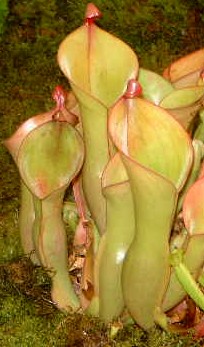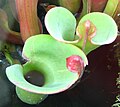Heliamphora nutans: Difference between revisions
Appearance
Content deleted Content added
m robot Modifying: de:Heliamphora nutans |
Mgiganteus1 (talk | contribs) + ref, copyedit |
||
| Line 16: | Line 16: | ||
}} |
}} |
||
'''''Heliamphora nutans''''' ([[Latin]]: ''nutans'' = nodding) is a species of [[Heliamphora| |
'''''Heliamphora nutans''''' ([[Latin]]: ''nutans'' = nodding) is a species of [[Heliamphora|marsh pitcher plant]] native to [[Venezuela]], [[Brazil]] and [[Guyana]], where it grows on several [[tepui]]s, including [[Mount Roraima|Roraima]], Kukenan, Tramen and Ilu. ''Heliamphora nutans'' was the first ''Heliamphora'' to be described and is the best known species. |
||
''Heliamphora nutans'' was originally discovered in 1839 on [[Mount Roraima]] by the two brothers [[Robert Hermann Schomburgk|Robert]] and [[Moritz Richard Schomburgk|Richard Schomburgk]],<ref name = "Orchids">{{cite web| url= http://www.orchids.co.in/orchidologists/david-burke.shtm|title = David Burke (1854 – 1897) |author= |publisher = www.orchids.co.in|accessdate=7 November 2008}}</ref> although they did not collect samples to return to Europe. In 1881, [[David Burke (botanist)|David Burke]] was plant-hunting in the same area of [[British Guiana]] where he collected specimens of the plant and introduced it to [[England]].<ref name = "HV87">{{cite book | author=[[James Herbert Veitch]]| title=[[Hortus Veitchii]]| publisher=[[Caradoc Doy]] | year=2006 reprint| isbn=0-9553515-0-2|page=87}}</ref> |
''Heliamphora nutans'' was originally discovered in 1839 on [[Mount Roraima]] by the two brothers [[Robert Hermann Schomburgk|Robert]] and [[Moritz Richard Schomburgk|Richard Schomburgk]],<ref name = "Orchids">{{cite web| url= http://www.orchids.co.in/orchidologists/david-burke.shtm|title = David Burke (1854 – 1897) |author= |publisher = www.orchids.co.in|accessdate=7 November 2008}}</ref> although they did not collect samples to return to Europe. In 1881, [[David Burke (botanist)|David Burke]] was plant-hunting in the same area of [[British Guiana]] where he collected specimens of the plant and introduced it to [[England]].<ref name = "HV87">{{cite book | author=[[James Herbert Veitch]]| title=[[Hortus Veitchii]]| publisher=[[Caradoc Doy]] | year=2006 reprint| isbn=0-9553515-0-2|page=87}}</ref> |
||
| Line 29: | Line 29: | ||
==References== |
==References== |
||
{{reflist}} |
{{reflist}} |
||
* Adlassnig, W., K. Pranji, E. Mayer, G. Steinhauser, F. Hejjas & I.K. Lichtscheidl 2010. The abiotic environment of ''Heliamphora nutans'' (Sarraceniaceae): pedological and microclimatic observations on Roraima Tepui. ''Brazilian Archives of Biology and Technology'' '''53'''(2): 425–430. {{DOI|10.1590/S1516-89132010000200022}} |
|||
* Bentham, G. 1840. ''Heliamphora nutans''. ''The Transactions of the Linnean Society of London'' '''18''': 429–432. |
* Bentham, G. 1840. ''Heliamphora nutans''. ''The Transactions of the Linnean Society of London'' '''18''': 429–432. |
||
* Gonzalez, J.M., K. Jaffe & F. Michelangeli 1991. Competition for Prey Between the Carnivorous Bromeliaceae ''Brocchinia reducta'' and Sarraceniaceae ''Heliamphora nutans''. ''Biotropica'' '''23'''(4B): 602–604. |
* Gonzalez, J.M., K. Jaffe & F. Michelangeli 1991. Competition for Prey Between the Carnivorous Bromeliaceae ''Brocchinia reducta'' and Sarraceniaceae ''Heliamphora nutans''. ''Biotropica'' '''23'''(4B): 602–604. |
||
Revision as of 00:14, 4 December 2012
| Heliamphora nutans | |
|---|---|

| |
| Heliamphora nutans | |
| Scientific classification | |
| Kingdom: | |
| (unranked): | |
| (unranked): | |
| (unranked): | |
| Order: | |
| Family: | |
| Genus: | |
| Species: | H. nutans
|
| Binomial name | |
| Heliamphora nutans Benth. (1840)
| |
| Synonyms | |
| |
Heliamphora nutans (Latin: nutans = nodding) is a species of marsh pitcher plant native to Venezuela, Brazil and Guyana, where it grows on several tepuis, including Roraima, Kukenan, Tramen and Ilu. Heliamphora nutans was the first Heliamphora to be described and is the best known species.
Heliamphora nutans was originally discovered in 1839 on Mount Roraima by the two brothers Robert and Richard Schomburgk,[1] although they did not collect samples to return to Europe. In 1881, David Burke was plant-hunting in the same area of British Guiana where he collected specimens of the plant and introduced it to England.[2]
-
Heliamphora nutans at Kew Gardens, London
-
Heliamphora nutans growing on Mount Roraima in Venezuela
-
Detail of H. hutans flower
-
Heliamphora nutans. Taken at Princess of Wales Conservatory, Kew Gardens, (London, UK)
References
- ^ "David Burke (1854 – 1897)". www.orchids.co.in. Retrieved 7 November 2008.
- ^ James Herbert Veitch (2006 reprint). Hortus Veitchii. Caradoc Doy. p. 87. ISBN 0-9553515-0-2.
{{cite book}}: Check date values in:|year=(help)
- Adlassnig, W., K. Pranji, E. Mayer, G. Steinhauser, F. Hejjas & I.K. Lichtscheidl 2010. The abiotic environment of Heliamphora nutans (Sarraceniaceae): pedological and microclimatic observations on Roraima Tepui. Brazilian Archives of Biology and Technology 53(2): 425–430. doi:10.1590/S1516-89132010000200022
- Bentham, G. 1840. Heliamphora nutans. The Transactions of the Linnean Society of London 18: 429–432.
- Gonzalez, J.M., K. Jaffe & F. Michelangeli 1991. Competition for Prey Between the Carnivorous Bromeliaceae Brocchinia reducta and Sarraceniaceae Heliamphora nutans. Biotropica 23(4B): 602–604.
- McPherson, S. 2007. Pitcher Plants of the Americas. The McDonald & Woodward Publishing Company, Blacksburg, Virginia.
Wikimedia Commons has media related to Heliamphora nutans.




